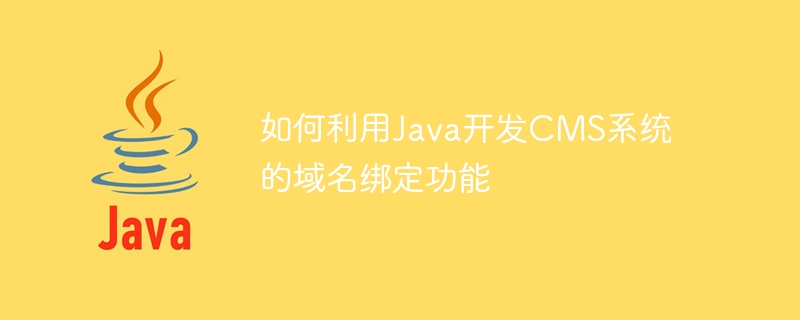Home >Java >javaTutorial >How to use Java to develop the domain name binding function of CMS system
How to use Java to develop the domain name binding function of CMS system
- WBOYWBOYWBOYWBOYWBOYWBOYWBOYWBOYWBOYWBOYWBOYWBOYWBOriginal
- 2023-08-26 19:15:261393browse

How to use Java to develop the domain name binding function of the CMS system
With the development of the Internet, more and more companies and individuals have begun to build their own websites. In order to provide a better user experience, many websites provide domain name binding functions, allowing users to point their domain names to specific pages of the website. This article will introduce how to use Java to develop the domain name binding function of the CMS system and provide code examples.
First of all, we need to understand the principle of domain name binding. Domain name binding is achieved by resolving the user's domain name to the specified IP address. In Java, we can use Servlet technology to implement domain name resolution.
In the CMS system, we need to first implement the domain name binding configuration function. Users can add and manage domain name binding information in the system settings. We can design an entity class bound to a domain name, including the domain name and the corresponding page path. Then, these configuration information are stored and read through the database.
Next, we need to write a Servlet to handle domain name binding requests. In the doGet or doPost method, we can first obtain the domain name visited by the user, and then find the corresponding page path based on the domain name. Finally, the request is forwarded to the corresponding page.
The following is a simple code example:
@WebServlet("/domain")
public class DomainServlet extends HttpServlet {
protected void doGet(HttpServletRequest request, HttpServletResponse response) throws ServletException, IOException {
String domain = request.getServerName(); // 获取用户访问的域名
// 根据域名查找对应的页面路径
String page = DomainBindingService.getPageByDomain(domain);
if (page != null) {
// 将请求转发到对应的页面
request.getRequestDispatcher(page).forward(request, response);
} else {
// 没有找到对应的域名配置
response.sendError(HttpServletResponse.SC_NOT_FOUND);
}
}
}In the above example, we use a DomainBindingService class to read and query domain name binding information in the database. You can use JDBC or ORM framework to interact with the database depending on the specific situation.
In addition, in order for the domain name binding function to take effect, we also need to perform corresponding configuration on the server. For example, all requests can be forwarded to the DomainServlet we wrote:
<servlet>
<servlet-name>DomainServlet</servlet-name>
<servlet-class>com.example.DomainServlet</servlet-class>
</servlet>
<servlet-mapping>
<servlet-name>DomainServlet</servlet-name>
<url-pattern>/*</url-pattern>
</servlet-mapping>Through the above configuration, we can implement the domain name binding function of a simple CMS system. Users only need to add the domain name and the corresponding page path in the system to bind their domain name to a specific page of the website.
It should be noted that the domain name binding function may bring some security risks. In order to prevent malicious access and attacks, we need to check and filter the domain names and page paths submitted by users for legitimacy. You can restrict users to only bind verified domain names to avoid binding to unsafe pages.
To sum up, it is relatively simple to use Java to develop the domain name binding function of the CMS system. Through reasonable design and configuration, we can easily implement domain name resolution and page forwarding. Such functions can improve the user experience of the website and the image of the company, and increase the traffic and revenue of the website.
The above is the detailed content of How to use Java to develop the domain name binding function of CMS system. For more information, please follow other related articles on the PHP Chinese website!

